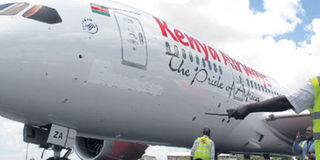Why Kenya Airways pilots went on strike despite court order

A Kenya Airways plane at the Jomo Kenyatta International Airport in Nairobi. As part of the truce that returned aircraft to the skies on April 29, 2016, Kenya Airways management suspended its staff rationalisation — a euphemism for retrenchments. FILE | PHOTO | NATION MEDIA GROUP
What you need to know:
- And those on one flight that started before noon on Thursday and another one that started after that time were to do the first flight and then return the aircraft to base and head for Rubani House.
- They accuse Mr Ngunze of being part of the management that flew the airline into its financial wilderness, posting losses of up to Sh30 billion in three years.
- The court did not order a retention of the status quo as the parties negotiated and the pilots were apprehensive that early retirement letters, dismissals and redeployments would follow in short order.
The ink was hardly dry on a deal to avert Kenya Airways pilots strike on Wednesday than the warring parties locked horns again.
At 5.30pm on that day, a joint statement by Kenya Airways management and the Kenya Airline Pilots Association said that the strike notice had been deferred to June 1.
But almost immediately afterwards, the association sent a terse notice to its members. “After our deliberation this evening, it has been decided that in case our demands are not met, the strike will commence tomorrow from noon. I call upon all of you to report at Rubani House in full uniform at 10am tomorrow morning April 28.”
The message was signed by Secretary-General Paul Gichinga.
The following morning, Rubani House at Embakasi, not far from Kenya Airways headquarters, was teeming with pilots. The strike was on, they were told.
The strike was to begin at noon on Thursday. All pilots were to report at Rubani House at 10am for roll call.
Pilot managers are Chief Pilot, Technical Pilot, Director Flight Operations and Fleet Managers.
It included those reporting for duty at noon and those on off, standby, ground training and office duties.
Crews on ground training were required to leave training at noon and report to Rubani House.
And those on one flight that started before noon on Thursday and another one that started after that time were to do the first flight and then return the aircraft to base and head for Rubani House.
The effect of all this was immediate. Beginning noon on Thursday, cancellations started.
The airline’s Chief Executive Mbuvi Ngunze said the action went "against the agreement legitimately arrived at after hours of consultation with union representatives."
BOSSES PUNISHED
The operation and financial consequences will only become apparent later on Saturday.
As one of the multiplicity of reasons they were going on strike, the pilots were demanding Mr Ngunze’s head.
They have done this for as long as he has been head of Kenya Airways and show no signs of relenting.
They accuse him of being part of the management that flew the airline into its financial wilderness, posting losses of up to Sh30 billion in three years.
Saturday Nation sent Mr Ngunze some questions but by the time of going to press, he had not responded.
Why did the pilots go back on an agreement they had signed? Fear. Many of them, it turned out, feared that management would use the one-month window ordered by the courts to get rid of them.
The court did not order a retention of the status quo as the parties negotiated and the pilots were apprehensive that early retirement letters, dismissals and redeployments would follow in short order.
They told their executive committee members that as far they were concerned, the strike was on. Anxious to maintain unity, the executive committee went along.
That’s when they came out with an unstated set of minimum demands without which the pilots would not fly.
Late Thursday night, Alban Mwendar, the airline’s group human resources director resigned. Alex Avedi, the director of corporate quality, safety and security and Capt Paul Mwangi, the director of flight operations, were sent on compulsory leave.
SAME REMEDY
The pilots association declared victory after “tough deliberations and negotiations.”
Mr Ngunze must regard with foreboding the association’s letter to its members: “We expect more management changes by the June 1 deadline. The state of our union is indeed strong.”
As part of the truce that returned aircraft to the skies Friday, Kenya Airways management suspended its staff rationalisation — a euphemism for retrenchments.
The airline retrenched in 2012 with disastrous consequences. It was also ordered to reverse its decisions by a court.
In 2016, the airline is applying the same medicine for the same problem, which is now worse. In a word, Kenya Airways is doing the same thing and expecting different results.




